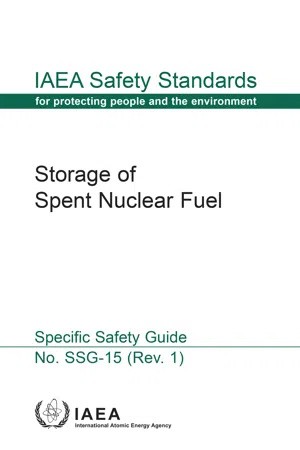1. INTRODUCTION
Background
1.1. Spent nuclear fuel is generated from the operation of nuclear reactors of all types and needs to be safely and securely managed following its removal from the reactor core. Spent fuel is considered waste in some circumstances or a potential future energy resource in others and, as such, management options might involve direct disposal (as part of what is generally known as the ‘once through fuel cycle’) or reprocessing (as part of what is generally known as the ‘closed fuel cycle’). Either management option will involve a number of steps, which will necessarily include storage of the spent fuel for some period of time. This time period for storage can differ, depending on the management strategy adopted, from a few months to several decades. The time period for storage will be a significant factor in determining the storage arrangements adopted. The final management option might not have been determined at the time of design of the storage facility, leading to some uncertainty in the storage period that will be necessary, a factor that needs to be considered in the adoption of a storage option and the design of the facility. Storage options include wet storage in some form of storage pool, or dry storage in a facility or in storage casks built for this purpose. Storage casks can be located in a designated area on a site or in a designated storage building. A number of different designs for both wet and dry storage have been developed and used in different States.
1.2. Irrespective of the consideration of spent fuel (either waste or an energy resource), the requirements for the storage of spent fuel are the same as those for the storage of radioactive waste, which are established in IAEA Safety Standards Series No. GSR Part 5, Predisposal Management of Radioactive Waste [1].
1.3. The safety of a spent fuel storage facility, and of the spent fuel stored within it, is ensured by appropriate confinement of the radionuclides involved, maintaining subcriticality, heat removal, radiation shielding and retrievability of the spent fuel or spent fuel packages. These functions are ensured by the proper siting, design, construction and commissioning of the storage facility, and its proper management and safe operation. At the design stage, due consideration also needs to be given to the future decommissioning of the facility.
1.4. Spent fuel is generated continually by operating nuclear reactors. It is stored in the reactor fuel storage pool for a period of time for cooling and then may be transferred to a designated wet or dry storage facility, where it will await reprocessing or disposal (if it is considered to be radioactive waste). The spent fuel storage pools of some reactors have sufficient capacity to accommodate all the spent fuel that will be generated during the lifetime of the reactor.
1.5. The basic safety aspects for the storage of spent fuel are applicable to the storage of spent fuel from research reactors as well as from power reactors. For research reactors, an approach should be adopted that takes into account the differences between the fuel types (e.g. the lower heat generation of research reactor fuel, its higher enrichment level and cladding materials that are less corrosion resistant) when determining the measures to be taken to ensure confinement, heat removal, criticality control, radiation shielding and retrievability.
1.6. Many spent fuel storage facilities at reactors were intended to serve for a limited period of time (a few years) as a place to keep spent fuel between unloading from the reactor and its subsequent storage, reprocessing or disposal. In view of the time being taken to develop disposal facilities and the limited reprocessing programmes that have been developed, storage periods are being extended from years to decades. This change in approach to the management of spent fuel has been accompanied by other developments, for example increases in enrichment, increases of burnup, use of advanced fuel design and mixed oxide fuel, re-racking, use of burnup credit and, in some cases, extension of storage periods beyond the original design lifetime of the storage facility. Nevertheless, storage cannot be considered the ultimate solution for the management of spent fuel, which requires a defined end point such as reprocessing or disposal in order to ensure safety. The design lifetime of a nuclear installation is generally of the order of decades, and experience with the storage of spent fuel of up to around 50 years has accrued. While design lifetimes of up to 100 years have been considered and adopted for certain spent fuel storage facilities, in view of the rate of industrial and institutional change, periods beyond around 50 years are deemed to be ‘long term’ in the context of this Safety Guide (see also Annex I).
1.7. The present publication supersedes the 2012 edition of SSG-15. This Safety Guide complements IAEA Safety Standards Series No. WS-G-6.1, Storage of Radioactive Waste [2], and can be read in conjunction with it.
1.7A. The terms used in this Safety Guide are to be understood as defined and explained in the IAEA Safe...
